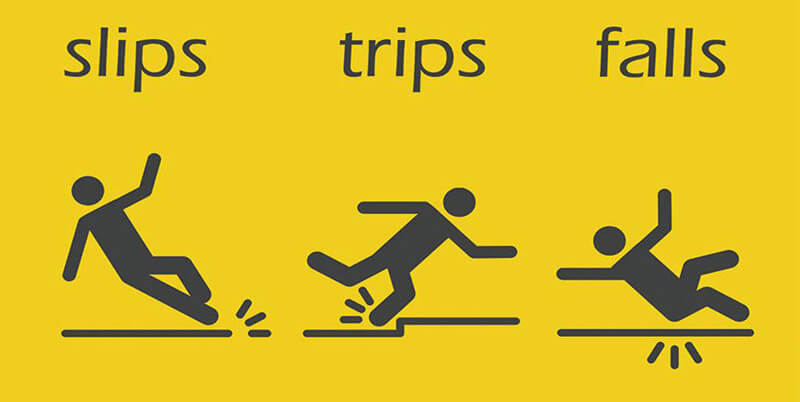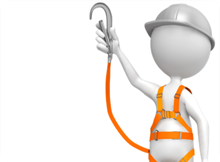 If you don’t use them properly, they can kill and injure people. Follow this advice to help you and those you work with stay safe.
If you don’t use them properly, they can kill and injure people. Follow this advice to help you and those you work with stay safe.
Operating
Always:
■ carry out a pre-shift check of the lift truck;
■ wear operator restraints, where fitted;
■ look all around before moving off;
■ look in the direction of travel;
■ travel at a speed suitable for the location and the load you are carrying;
■ travel with the forks lowered, but clear of the ground;
■ watch out for pedestrians;
■ watch out for obstructions;
■ avoid sudden stops and violent braking;
■ slow down at corners, doorways, and at every danger spot and sound the horn where necessary;
■ apply the parking brake when leaving the lift truck;
■ face the lift truck and use steps and handholds when getting in or out.
Never:
■ operate a lift truck unless you are trained and authorised to do so;
■ use a lift truck or equipment you know is not working properly;
■ operate controls from outside the cab, unless it is designed so you can do this;
■ stand on or near the controls to reach the load or anything outside the cab;
■ travel on uneven ground unless the lift truck is suitable for this;
■ run over unprotected cables or flexible pipes;
■ try to carry out repairs – leave this to a qualified maintenance engineer;
■ operate a lift truck when under the influence of alcohol or drugs;
■ use mobile phones or other hand-held devices while operating or travelling.
Loads
Always:
■ observe floor loading limits – find out the weight of the laden lift truck;
■ ensure there is adequate clearance for the lift truck and load, including overhead;
■ lower loads at a safe speed;
■ use suitable attachments for lifting unusual or wide loads and follow the manufacturer’s instructions;
■ ensure you are properly trained, competent and authorised to operate the lift truck with the attachment being used.
Never:
■ lift loads greater than the capacity of the lift truck;
■ move a load that appears unsuitable or unstable (including on a damaged pallet);
■ travel with a bulky load which blocks your view;
■ travel with a raised load, unless the lift truck is designed for this;
■ use an attachment unless a competent person, an authorised dealer or manufacturer has derated the lift truck (reduced the actual capacity).
Slopes
Always:
■ travel slowly when going down slopes;
■ when carrying a load, ensure the forks face uphill when travelling up or down slopes;
■ without a load, ensure the forks face downhill when travelling up or down slopes;
■ adjust the tilt (where fitted) to suit the gradient and raise the forks to clear the ground.
Never:
■ attempt to turn on or travel across a ramp or a slope;
■ leave a lift truck on a gradient except in an emergency, in which case always chock the wheels.
People
Always:
■ use a safe work method when using working platforms.
Never:
■ lift a person on the forks, or on a pallet, or similar, balanced on the forks;
■ carry passengers, unless the lift truck is designed for this;
■ allow people to walk under raised forks or loads;
■ pick up a load if someone is standing close to it.
When you have finished working
Always:
■ park the lift truck on level ground, never on a slope;
■ leave the lift truck with the mast tilted forwards and the forks fully lowered, with the tips on the floor;
■ apply the parking brake, select neutral, switch off the engine and remove the key;
■ return keys or other activating devices to their place of safe-keeping.
Contact us if you require further information.
Join the blog page for further information – click here.
 HSE Guidance HSG150: Health and Safety in Construction, observes that falls are the largest cause of accidents and fatalities in the construction industry.
HSE Guidance HSG150: Health and Safety in Construction, observes that falls are the largest cause of accidents and fatalities in the construction industry.
The primary focus of guidance in this area tends to look at the general causes of falls, which are described under two categories; “working at height” or “slips and trips”, and in turn, support is offered on both of these topics, with the stated aim of helping with the identification of hazards, controlling risks and explaining how to “plan, organise, control, monitor and review health and safety throughout the life of a project”.
HSE also provides subject specific guidance looking at activities that may result in an increased risk of falls. Examples include roof work, ladders (and step ladders), scaffolding, mobile platforms, and fragile surfaces.
It should perhaps be noted that the guidance offered by HSE does not distinguish between “low” and “high” falls. This is in line with the approach adopted by legislation; for example, the Work at Height Regulations 2005 describe work at height as:
(a) work in any place, including a place at or below ground level,
(b) obtaining access to or egress from such place while at work, except by a staircase in a permanent workplace,
where, if measures required were not taken, a person could fall a distance liable to cause personal injury.
Falls from height are not the only potential cause of injury. Falls onto things, such as; hot work; wet concrete; protruding reinforcement; onto equipment, such as machinery; moving plant or vehicles, can also have serious consequences, regardless of the distance involved.
In all circumstances, HSE favours a risk-based approach, applied in the following three stages.
Firstly, measures should be put in place to avoid working in a way which could result in a fall. If that is not possible, then the amount of that work should be minimised, and as a last resort, protective measures should be put in place to mitigate the possible consequences of a fall.
The third item can also be subdivided into two parts, general or “collective” protective measures, such as guard rails or improved lighting, and personal protective measures, such as harnesses or protective clothing.
Protective measures may be categorised as “fall arrest” or “fall restraint” systems. The former stops someone who is experiencing a fall, for example by using a net or a harness, while the latter is designed to stop them falling in the first place, perhaps by means of guard rails, warnings or edge protection.
However, although the individual may also be a contributing factor, these kinds of accidents come about for one of two reasons; either the workplace itself is not safe, or access to the workplace is inadequate.
There are a number of ways of dealing with both issues, so let us look at some of the options.
 Prevention hierarchy
Prevention hierarchyThere are several measures which you can use to reduce or eliminate the incidence of falls. Most important among these are risk assessments. Every situation has its challenges, but by using simple techniques, the following hierarchy can be established.
In some cases, it may be appropriate for you to draw up a series of “method statement” showing the procedures to be undertaken to ensure certain activities can be carried out safely. These are sometimes referred to as risk assessment method statements (RAMS).
The introduction and advancement of new technology has introduced the possibility of many other control solutions, especially those involving remote detection and navigation.
As well as providing training and instruction to people who are at risk of falls, you can implement some relatively simple steps which can be taken to further ensure the safety of all concerned.
Accidents involving falls are among the commonest causes of injuries and death in the construction industry. It follows, therefore, that they should be one of the easiest to reduce and eliminate.
Although the industry has made significant improvements in recent years, there is still some distance to go. However, by following some simple guidelines, planning properly, with well-trained operatives using the right equipment in the right environment, we can continue to take steps in the right direction.
Contact us if you have any queries.
As an employer, you are required by law to prevent physical and mental ill health in your workers that may occur as a result of your business activities. Your risk assessment will help you decide what actions you need to take to do this.
An important part of occupational health is concerned with how work and the work environment can impact on workers’ health, both physical and mental. It also includes how workers’ health can affect their ability to do their job. Put simply this means the effect of work on health and that of health on work.
In health and safety law, there are things you must do to make sure workers’ health is not adversely affected by their work and that workers are medically fit to carry out their work safely.
Contact us should you require more information.
 The only UK-based charity for the work at height sector has announced that it is launching the first ever No Falls Week, to take place from 13–17 May 2024.
The only UK-based charity for the work at height sector has announced that it is launching the first ever No Falls Week, to take place from 13–17 May 2024.
The No Falls Foundation said this will be a key part of its campaign to raise awareness about the importance of safe working at height, to prevent falls and to ensure that everyone working at height comes down safely.
It is estimated that over one million businesses, and 10 million workers, carry out work involving some form of working at height every year. No Falls Week will provide the opportunity for organisations across all sectors to place a focus on work in this particular sector, which sees so many incidents.
Falls from height are consistently the leading cause of workplace fatalities in the UK, with 40 people losing their lives at work due to a fall from height in 2022/23. Latest figures from the Health and Safety Executive (HSE) show that falls from height were responsible for a third of all workplace deaths last year, up from a quarter the year before.
There are an even greater number of nonfatal injuries resulting from a fall from height, with over 5000 people in Great Britain having been reported injured at work in 2022/23.
The No Falls Foundation believes that there is substantial under-reporting of nonfatal falls from height for all workers, particularly the self-employed, who were found to report just 12% of workplace incidents.
According to the Labour Force Survey, HSE estimates the number of workplace falls from height over the last 10 years may be as many as 425,000.
To get involved, employers can sign up on the No Falls Week website, where they can find toolkits and resources from members of the Access Industry Forum (AIF) to help plan activities during the No Falls Week. This may include hosting toolbox talks, workshops or safety demonstrations, distributing informational materials and engaging in social media campaigns.
Contact us if you wish to find out more.
 Having worked in health and safety since 2004, I understand the vital role that PPE plays in keeping us safe. However, as someone who is 5 feet tall, I have encountered challenges with ill-fitting equipment and clothing that can impact both safety and productivity.
Having worked in health and safety since 2004, I understand the vital role that PPE plays in keeping us safe. However, as someone who is 5 feet tall, I have encountered challenges with ill-fitting equipment and clothing that can impact both safety and productivity.
Changes are being made to accommodate people of all shapes and sizes so that they are safe and can be seen in the workplace.
Katy Robinson is a PPE campaigner, she spoke to SHP Magazine about raising awareness for inclusive PPE, click here to read her article.
I was asked to write an article for them too. My article can be read here.
If you want to find out more or need help in finding PPE that fits, please contact me.
Health and Safety Consultants | Telford, Shropshire, West Midlands (walkersafety.co.uk)